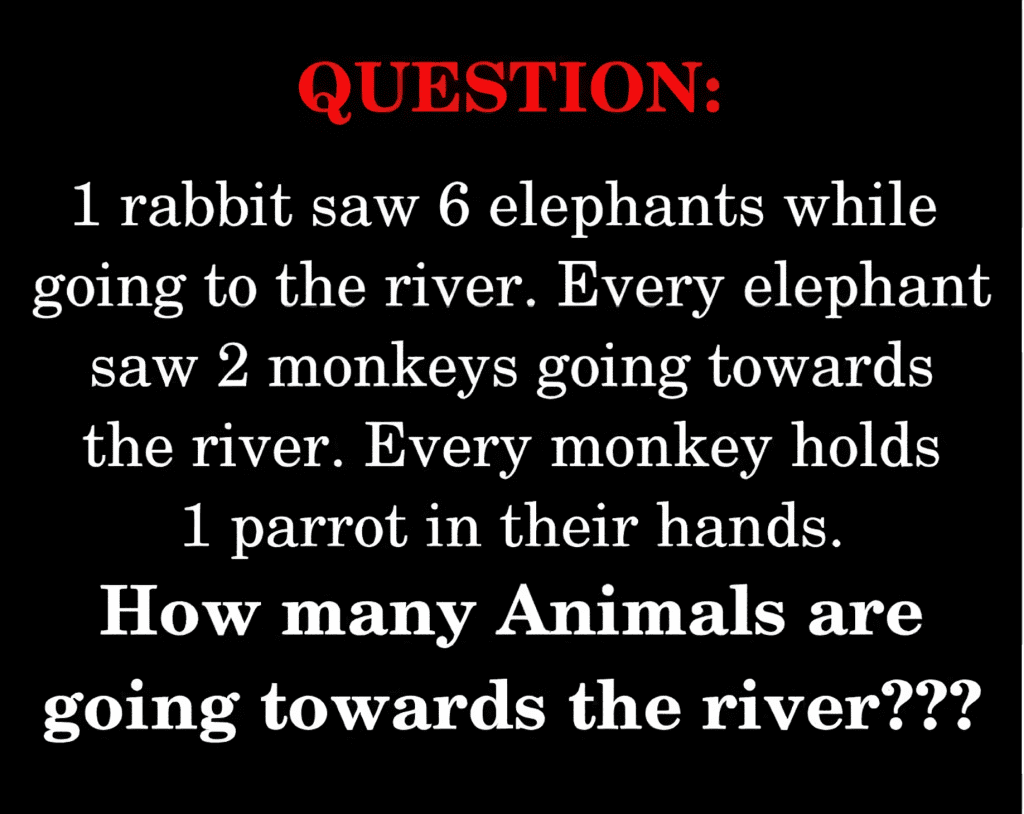Riddles are like little puzzles for your brain, challenging you to think outside the box and discover hidden meanings beneath the surface. Today, we’re tackling a riddle that’s been puzzling minds across the internet. This clever brainteaser pits the power of language against the precision of math, forcing you to rely on both logic and interpretation. Ready to flex your mental muscles? Let’s dive into this head-scratcher!
The Riddle That’s Gone Viral

Here’s the riddle that’s got everyone talking:
“1 rabbit saw 6 elephants while going to the river. Every elephant saw 2 monkeys going towards the river. Every monkey holds 1 parrot in their hands. How many animals are going towards the river?”
At first glance, it seems like a straightforward math problem. You might be tempted to start multiplying the animals, tallying up rabbits, elephants, monkeys, and parrots. But hold on! This riddle is trickier than it appears, and the key to solving it lies in how you interpret the wording.
Let’s break it down step by step.
Sentence One: The Rabbit’s Journey
“1 rabbit saw 6 elephants while going to the river.”
This first sentence is clear and straightforward. The rabbit is going to the river, which means we’ve got one animal heading toward the water. So far, so good!
Sentence Two: The Elephants’ Observation
“Every elephant saw 2 monkeys going towards the river.”
Now, this is where things get tricky. Your first instinct might be to assume that each of the 6 elephants saw 2 different monkeys, leading you to multiply 6 by 2, giving you 12 monkeys. But the riddle never explicitly says that each elephant saw a different pair of monkeys. Instead, it suggests that all 6 elephants saw the same 2 monkeys.
So, how many monkeys are going towards the river? Just two! This is where careful reading becomes crucial. The riddle’s ambiguous language is designed to lead you into overcomplicating the situation.
Sentence Three: The Parrots’ Role
“Every monkey holds 1 parrot in their hands.”
This sentence tells us that each of the 2 monkeys is holding a parrot. So, we’ve got 2 parrots, one for each monkey. Since the monkeys are heading towards the river, their parrots are also going along for the ride. That adds two parrots to our total.
Calculating the Total: The Final Answer
Now, let’s tally up the animals heading towards the river:
- 1 rabbit (from the first sentence)
- 2 monkeys (observed by the elephants)
- 2 parrots (held by the monkeys)
So, the total number of animals going towards the river is five: 1 rabbit, 2 monkeys, and 2 parrots.
Why the Riddle Is So Deceptive
This riddle is a perfect example of how careful reading and logical deduction can turn what seems like a simple problem into a tricky challenge. At its core, the riddle plays with our natural tendency to overanalyze numbers and make assumptions about relationships between the animals. However, by paying close attention to the wording, we see that the solution lies in a much simpler interpretation.
Here’s why this riddle is particularly deceptive:
- Ambiguous language: The riddle carefully avoids specifying whether each elephant saw a different set of monkeys, leaving room for multiple interpretations. This forces you to question your initial assumptions and read between the lines.
- Context matters: While math is about precise numbers and calculations, language is about nuance and interpretation. This riddle blends the two, requiring you to apply both skills to arrive at the correct answer.
- Misleading simplicity: The question might seem simple at first, but it’s designed to trick you into overthinking the relationships between the animals. By keeping the numbers small and the phrasing subtle, the riddle creates a sense of confusion.
Why Context Matters in Problem-Solving
One of the most valuable lessons from this riddle is the importance of context. When faced with a problem, it’s easy to rush to conclusions based on the numbers or facts presented. However, the way those facts are framed can dramatically impact how you interpret the solution.
In this case, the riddle uses ambiguous language to create confusion. The key to solving it lies in recognizing that not every word should be taken at face value. By considering the broader context, you can arrive at the correct answer.
Conclusion: Don’t Overthink It—Riddles Are All About Perspective
The beauty of this riddle lies in its simplicity. While it seems designed to trip you up, the solution is straightforward once you strip away the layers of complexity. It’s a reminder that sometimes, the best way to solve a problem is to take a step back and look at the bigger picture.
So, did you get the answer right? Whether you guessed five animals or fell for the riddle’s tricks, there’s no denying the fun of the challenge. Next time you encounter a riddle, remember to embrace the process, question your assumptions, and enjoy the satisfaction of solving a puzzle designed to test both your language skills and your logic.
And now that you’ve cracked the code on this one, why not challenge your friends and see if they can outsmart the riddle too?


